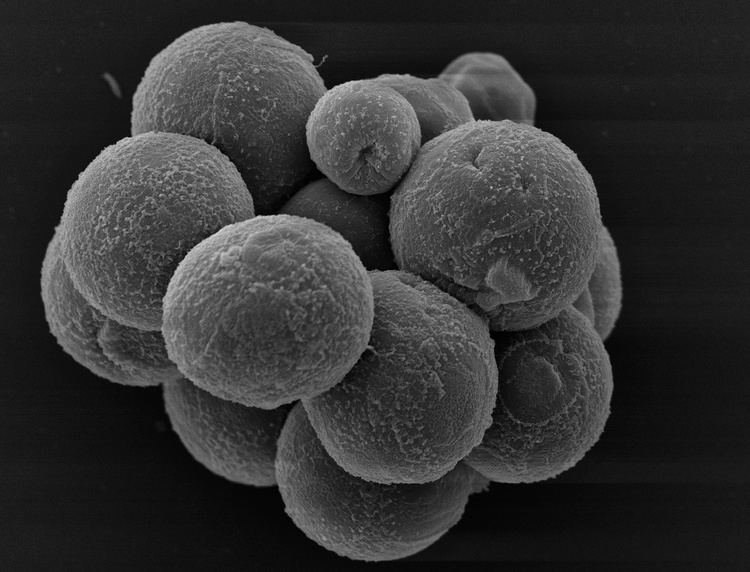The Mesomycetozoea (or DRIP clade, or Ichthyosporea) are a small group of Opisthokonta in Eukarya (formerly protists), mostly parasites of fish and other animals.
They are not particularly distinctive morphologically, appearing in host tissues as enlarged spheres or ovals containing spores, and most were originally classified in various groups as fungi, protozoa, or colorless algae. However, they form a coherent group on molecular trees, closely related to both animals and fungi and so of interest to biologists studying their origins. In a 2008 study they emerge robustly as the sister-group of the clade Filozoa, which includes the animals.
Huldtgren et al., following x-ray tomography of microfossils of the Ediacaran Doushantuo Formation, has interpreted them as mesomycetozoan spore capsules.
The name DRIP is an acronym for the first protozoa identified as members of the group, Cavalier-Smith later treated them as the class Ichthyosporea, since they were all parasites of fish.
order Dermocystida"D": Dermocystidium. One species, Rhinosporidium seeberi, infects birds and mammals, including humans."R": the "rosette agent", now known as Sphaerothecum destruensorder Ichthyophonida"I": Ichthyophonus"P": PsorospermiumSince other new members have been added (e.g. the former fungal orders Eccrinales and Amoebidiales), Mendoza et al. suggested changing the name to Mesomycetozoea, which refers to their evolutionary position. On Eukaryota tree, in Opisthokont clade, Mesomycetozoea is in the middle ("Meso-") of the fungi ("-myceto-") and the animals ("-zoea"). Note the name Mesomycetozoa (without a second e) is also used to refer to this group, but Mendoza et al. use it as an alternate name for the phylum Choanozoa.
Class Ichthyosporea Cavalier-Smith 1998Order Dermocystida Cavalier-Smith 1998Family Rhinosporidiaceae Mendoza et al. 2001Genus Sphaerothecum Arkush et al. 2003 (Rosette agent)Genus Rhinosporidium Minchin & Fantham 1905Genus Amphibiocystidium Pascolini et al. 2003Genus Dermocystidium Pérez 1908 [Dermocystis Pérez 1907 non]Genus Amphibiothecum Feldman, Wimsatt & Green, 2005Genus Dermosporidium Carini 1940Order Ichthyophonida Cavalier-Smith 1998Suborder Sphaeroformina Cavalier-Smith 2012Genus Caullerya Chatton 1907Family Psorospermidae Cavalier-Smith 2012Genus Psorospermis Cavalier-Smith 2012 [Psorospermium Hilgendorf 1883 non Eimer 1870]Family Piridae Cavalier-Smith 2012Genus Abeoforma Marshall & Berbee 2011Genus Pirum Marshall & Berbee 2011Family Creolimacidae Cavalier-Smith 2012Genus Anurofeca Baker, Beebee & Ragan 1999Genus Pseudoperkinsus Figueras et al. 2000Genus Creolimax Marschall et al. 2008Genus Sphaeroforma Jostensen et al. 2002Suborder Trichomycina Cavalier-Smith 2012Family Ichthyophonidae Cavalier-Smith 2012Genus Ichthyophonus Plehn & Mulsow 1911Family Amoebidiidae Lichtenstein 1917 ex Kirk et al. 2001Genus Amoebidium Cienkowski 1861Genus Paramoebidium Léger & Duboscq 1929Family Palavasciaceae Manier & Lichtward 1968Genus Palavascia Tuzet & Manier 1947 ex Lichtwardt 1964Family Parataeniellaceae Manier & Lichtward 1968Genus Lajassiella Tuzet & Manier 1951 ex Manier 1968Genus Nodocrinella Scheer 1977Genus Parataeniella Poiss. 1929Family Eccrinaceae Leger & Duboscq 1929Genus Alacrinella Manier & Ormières ex Manier 1968Genus Arundinula Léger & Duboscq 1906 [Arundinella Léger & Duboscq 1905 non Raddi 1823]Genus Astreptonema Hauptfleisch 1895 [Astereptonema Hauptfleisch 1895; Eccrinella Léger & Duboscq 1933]Genus Eccrinidus Manier 1970Genus Eccrinoides Léger & Duboscq 1929Genus Enterobryus [Andohaheloa Manier 1955; Capillus Granata 1908; Cestodella Tuzet, Manier & Jolivet 1957; Daloala Tuzet, Manier & Vog.-Zuber 1952; Eccrina Leidy 1852; Eccrinopsis Léger & Duboscq 1916; Lactella Maessen 1955; Paratrichella Manier 1947; Pistillaria Jeekel et al. 1959 non Fries 1821; Recticoma Scheer 1935; Trichella Léger & Duboscq 1929; Trichellopsis Maessen 1955]Genus Enteromyces Lichtwardt 1961Genus Enteropogon Hibbits 1979 non Nees 1836Genus Leidyomyces Lichtwardt et al. 1999Genus Paramacrinella Manier & Grizel 1971Genus Passalomyces Lichtwardt et al. 1999Genus Ramacrinella Manier & Ormiéres 1962 ex Manier 1968Genus Taeniella Léger & Duboscq 1911Genus Taeniellopsis Poiss. 1927
